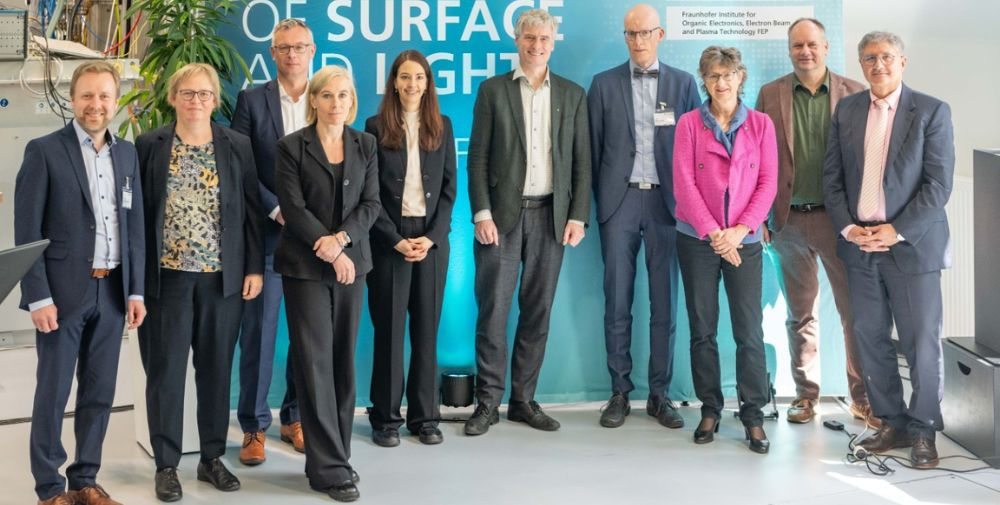
As one of the first Fraunhofer Institutes in Dresden, the Fraunhofer Institute for Electron Beam and Plasma Technology FEP has been a fixture in the research landscape of the Saxon state capital for more than 30 years. With its specialized core competencies in electron beam and plasma technology, the institute develops innovative surface functionalization processes and vacuum technologies for a wide variety of substrates, from flexible films and bulk materials to metal strips and ultra-thin glass.
In addition to coating and process development for customers and partners from a wide range of industries, the Fraunhofer FEP is uniquely able to offer these processes from laboratory tests to pilot production from a single source in-house. This provides customers with a reliable basis for transferring entire surface coating processes to industry. For this purpose, the institute has plant technology ranging from laboratory scale to industry-oriented sheet-to-sheet and roll-to-roll coating lines and systems for precision coating.
In order to be able to continue offering innovative technologies for sustainable solutions of the future and to research and develop close to the pulse of the times, the campus has been expanded in recent years by several buildings and areas at Winterbergstraße 31f in Dresden. In addition to a technical center for nanotechnologies and precision coating, the last construction phase of the Fraunhofer Research Center for RESource-Efficient Energy Technologies (RESET) has now been completed for the Fraunhofer FEP.
In a festive inauguration ceremony, Institute Director Prof. Elizabeth von Hauff, together with State Secretary Prof. Thomas Popp and the President of the Fraunhofer-Gesellschaft Prof. Holger Hanselka, and the Chief Executive Officer of the Fraunhofer-Gesellschaft, opened the new building. Holger Hanselka and the Lord Mayor of the state capital Dresden, Dirk Hilbert, opened the now completed Fraunhofer Campus.
Prof. Elizabeth von Hauff is delighted: “I am pleased and proud that the campus has been expanded to include state-of-the-art laboratories for biomedical applications, a clean room for our research in the field of sputter epitaxy and attractive rooms for creative and collaborative work for our researchers. I would like to thank the Free State of Saxony, the Fraunhofer-Gesellschaft and the state capital Dresden for their many years of support for this project at all levels. I would also like to express my special thanks to all the colleagues involved at the institute who have driven this project forward over the years. They have put their heart and soul into the project and made the construction of a flagship for energy-efficient and sustainable buildings for applied research and development possible.”
Electron Beam Competence and Technology Center for Biomedicine and Environmental Technologies
The planned research projects at RESET will be determined by the establishment of a globally unique electron beam competence and technology center. Based on the already established competence center for thermal electron beam technologies at RESET and the significantly broader research base of the Fraunhofer FEP in the fields of electron beam applications, the future viability of the competence and technology center is to be ensured by establishing further fields of work.
The completed building ensemble now houses facilities for the development of non-thermal electron beam technologies for medical, biotechnology, environmental and energy applications. They create the basis, for example, for the sterilization and hygienization of medical products, efficient plasma-chemical synthesis processes and the chemical-free treatment of seeds.
Furthermore, a beam room with X-ray-safe shielding of up to 600 keV offers the opportunity to test and advance in-house new developments in the field of electron beam technology in accordance with market and customer requirements. One example of this is the development of new types of electron beam sources, e.g. for the high-throughput treatment of gases and liquids.
In addition, research is being conducted in a newly established biomedical laboratory complex on topics such as new processes with electron-stimulated microorganisms for metal recovery through bioleaching or for the production of bio-based materials. The use of photosynthetic microorganisms for the sustainable and CO2-neutral provision of raw materials is also to be investigated. In the near future, these laboratories can be operated with biological protection level 2 in order to best serve new sustainable fields of application in life science and environmental technology.
Thin-film plasma technologies
A clean room has also been set up for research into highly innovative process technologies for sputter epitaxy. A Fraunhofer FEP research group is dedicated to the development of magnetrons and process technologies to deposit thin films, e.g. gallium nitride (GaN) films, on 200 mm silicon wafers and to obtain epitaxial layers. The resulting GaN semiconductors with high-precision layers are to be used in future in power electronics or in applications such as light-emitting diodes (LEDs). Over the course of the year, the research group will have a new wafer-based high-temperature and ultra-high-vacuum PVD system available for this purpose and will be equipped with wafer handling in accordance with ISO3 for the first time.
Energy management and resource conservation
In addition to the ultra-modern facilities of the building complex, which now unites previously completed parts of the new research campus with new connecting bridges, great attention was paid to sustainable use and energy-efficient building supply throughout the construction phase. The Fraunhofer FEP is a leader within the Fraunhofer-Gesellschaft in the use of energy management systems and their practical application in operation. The resource-conserving provision and use of any energy is implemented, among other things, through the extraction of cooling energy from the groundwater, the use of waste heat from the test facilities for heating the building, air conditioning of the laboratories and the clean room by means of adiabatic exhaust air humidification, self-generation of electricity through a PV system and state-of-the-art control of the building technology using a weather forecasting tool as well as sustainable green roofs.
The official opening of the building complex was attended by many invited guests from industry and politics as well as institutions involved in the construction and the Fraunhofer FEP Board of Trustees. Institute Director Prof. Elizabeth von Hauff then gave the Saxon State Secretary Prof. Thomas Popp and the Lord Mayor of the state capital Dresden Dirk Hilbert a tour of the new premises and provided insights into the institute’s new research focus areas. Afterwards, all other guests had the opportunity to gain a closer insight into the topics of the Fraunhofer FEP during guided tours of the building.
– – – – – –
Further links
👉 www.fep.fraunhofer.de
Photo: Fraunhofer FEP, Photo: Ronald Bonss




